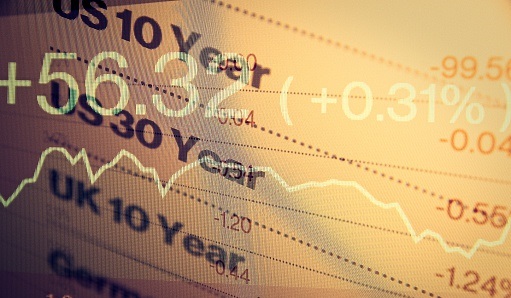US bond yields are on the move on the first day of the new week; the yield curve is bull steepening, with 30-year yields down about 3.5bps and 5-year yields down about 2bps. 10-year yields are currently just above 1.50%. The tech heavy Nasdaq 100 index is receiving a boost from favourable bond market price action and the E-mini Nasdaq 100 futures is up about 0.3% in pre-market trade and continues to trade very close to record high levels in the upper 14300s. Other major index futures are flat in broadly subdued pre-market conditions. Hawkish Fed vibes since the rate decision just over a week and a half ago appears to have resulted in financial market participants lowering their expectations for long-term economic growth and inflation (hence lower long-term yields), which could explain the divergence between US tech (which is more sensitive to long-term interest rates than to growth expectations) and other stocks (which are more sensitive to growth expectations).
All-in-all, however, markets seem confident that while the Fed has signalled a earlier start to the coming rate hike cycle, accommodative policy will remain the norm for the foreseeable future, which continues to give equity markets a boost more broadly – if market participants didn’t expect low interest rates for a long time, 30-year yields wouldn’t still be fairly close to record lows around 2.0%! Looking ahead, US equity and bond market trade is likely to remain subdued until at least Wednesday, when ADP will release their June Employment Change estimate. This will help to set expectations for Friday’s official NFP number, the release of which will be the main event on the week. US ISM Manufacturing PMI (released on Thursday) is also worth watching. With US monetary policy a key driver of risk appetite right now in wake of the Fed’s hawkish shift, some analysts are arguing markets will take the view that “bad data is good data”, in the sense that weaker than expected employment data this week might be seen as pushing back the Fed’s policy normalisation timeline. Fed speak will also be in focus this week.
Turning to other asset classes, crude oil prices saw fresh cycle highs during the overnight session but are back to flat this morning, with front-month WTI futures pivoting either side of the $74.00 level and Brent pivoting around $76.00. The global demand recovery/undersupply narrative remains supportive for the complex. The main focus this week is the OPEC+ meeting where analysts expect the group to go ahead with a planned output increase. Us/Iran nuclear talks have still not made a breakthrough and analysts are citing geopolitical events as complicating things; the US bombed some Iran-linked militias on the Iraq/Syria border over the weekend and the International Atomic Energy Agency’s agreement with Iran for a temporary continuation of their nuclear monitoring privileges in the country has now lapsed. Analysts are revising down their expectations for an imminent deal, which could be crude oil supportive, though some expect OPEC+ to see the ongoing lack of a US/Iran deal as a green light for further oil production hikes, so the market impact may be net neutral. Elsewhere, things still aren’t looking great for gold; spot prices continue to pivot either side of the $1780 mark and the failure to move back to test the $1800 level is telling that market participants remain worried that the Fed’s hawkish shift might be a harbinger of further losses ahead. Subdued bond yields and a US dollar that is yet to break out for further gains is for now acting as supportive. The key support level to the downside is the $1760 mark (the June low).
Turning to FX markets; it was a very unexciting week for the dollar last week, with Fed speak failing to meaningfully spice things up and the dollar instead consolidating recent gains. The DXY is currently trading close to 92.00, having dipped as low as 91.50 last week from post-hawkish Fed shift highs close to 92.50. Thus, DXY is in the middle of recent ranges. Bulls will take confidence from the fact that moves back towards the 200DMA last week seemingly attracted strong buying interest. As is the case with other asset classes, the main event of the week for the buck will be US data (ADP on Wednesday, ISM Manufacturing on Thursday and NFP on Friday) – strong data should have modestly hawkish Fed implications and should thus be a positive for the dollar. Fed speak in the coming days is worth watching, but speakers for now have not said anything unexpected given the spread of opinions implied by the recently updated FOMC dot-pot. The dollar is a little firmer this morning, with DXY up about 0.2% meaning most major G10 pairs have a negative bias at the start of the new week. EURUSD is just above 1.1900, down about 0.2%, GBPUSD is just under 1.3900 and is flat, USDJPY is close to 111.00, up about 0.1% and USDCAD is close to 1.2300, up about 0.2%. GBP seems to have shrugged off some political turmoil over the weekend with the resignation of UK Health Secretary Matt Hancock (to be replaced by former Chancellor of the Exchequer Sajid Javid) and reports that opposition leader Starmer may soon face a leadership challenge amid a spate of recent poor by-election performances. Some have argued that the new health secretary might be less “hawkish” with regards to future Covid-19 related lockdowns, i.e. that he will be more reluctant to implement restrictions, which could be a good sign for the economy, particularly as the UK goes back into flu season next winter.
Elsewhere, the Aussie does not seem overly concerned by the news over the weekend of an extension to the lockdown in Greater Sydney, which will see residents have their movements restricted until the 9th of July, as well as ominous comments from the Premier of New South Wales that officials are preparing for the prospect of a sharp increase in delta Covid-19 variant infections. AUDUSD is down a modest 0.3% amid the broadly stronger buck. Similarly, the Kiwi is also for now unconcerned by lockdown news; the city of Wellington is to see restrictions extended for two days after an Covid-19 infected Australian recently visited the area. NZDUSD is down about 0.4%.
The Day Ahead
The main focus of today will be on Fed speakers, with NY Fed President and key FOMC member John Williams speaking at 1400BST, followed by FOMC Vice Chairman for Supervision Randal Quarles up at 1810BST. Elsewhere, ECB Vice President de Guindos will be speaking at 1500BST. Otherwise, things are likely to be quiet.




